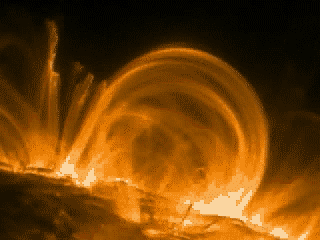 |
|
| Home | |
| Victor Hess | |
| Auger Project | |
| Coord.systems | |
| Terrestrial | |
| Galactic | |
| Celestial | |
| Space weather | |
| Unix Time | |
| Projects | |
| Ask me | |
| Contact | |
Space weather and cosmic rays
The sun's irradiance is not constant over timeThe solar activity changes as a function of time. To go from one maximum of solar activity to the next it takes an average of about 11 years. Sunspots which appear dark due to reduced surface temperature (about 2000°C cooler than their bright surrounding areas) are very active and numerous during a solar maximum.What is the reason for this cycle? |
|

Figure 1: Solar cycle and sunspots
left:Solar cycle right: sunspots at solar maximum (l), solar minimum (r) image credit: http://solarscience.msfc.nasa.gov/SunspotCycle.shtml http://earthobservatory.nasa.gov/IOTD/view.php?id=37575 |
|
The sun is magnetic!The Sun is mainly composed of hot ionized gas (plasma) in motion which generates an electrical current. These electrical currents in turn produce magnetic fields. Magnetic fields change over time and procude electric forces exerted on charged particles. During low solar activity the magnetic field lines are relatively straight and similar to the magnetic field lines of a bar magnet. However, the magnetic field gets twisted over time because the Sun's equator rotates faster than the poles. Finally, the magnetic field lines break through the Sun's surface which causes the development of sun spots. The Sun passes into a time of low activity once the Sun's magnetic field relaxes. |
|

Figure 3: The magnetic field lines get twisted
image from: http://sohowww.nascom.nasa.gov/gallery/Movies/animations.html Click the image to see how solar magnetic field lines get twisted. |
|

Figure 4: Coronal arcs showing the magnetic field
image credit:http://ircamera.as.arizona.edu/NatSci102/NatSci102/lectures/sun.htm Click the image to see the animation. |
A sun spot`s magnetic field is about 1.000 times stronger than the magnetic field at the Earth`s surface!A magnetic field at a sun spot traps the plasma and inhibits plasma from surrounding regions from entering. Thus, the trapped plasma cools faster than in the surrounding region. Sun spots are found in pairs since one of the spots represents the magnetic north pole and the other the magnetic south pole. |
|
Sun spots are active regions on the Sun's surface where coronal mass ejections occur very frequently during solar maxima. Click here to see a CME that erupts from the Sun in January 2002. |

Figure 5: Convection cells and magnetic field at a sun spot
image adapted from: http://cse.ssl.berkeley.edu/SEGwayed/lessons/ exploring_magnetism/in_Solar_Flares/ |
|
CMEs release huge amounts of charged particles (mainly electrons and protons) and electromagnetic radiation. Thus, CMEs change the magnetic field. It is very important to observe the solar activity because it can tremendously impact life
on Earth and space travel. |
|
|
Further links: |
|